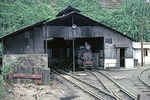 India_DHR_Kurseong_shed_B_779_SS_3882_1892_4_12_1979.jpg (152208 bytes)
India_DHR_Kurseong_shed_B_779_SS_3882_1892_4_12_1979.jpg (152208 bytes)|
The Railfaneurope.net Picture Gallery
Directory: /pix/ne/India/narrow_gauge/misc
Last update: Thu Sep 14 21:30:45 CEST 2023
|
| Two chickens scatch around in the dirt looking for food as Northeast Frontier Railway DHR NG (2ft) 0-4-0ST B 779 (Sharp Stewart 3882/1892) receives a boiler washout inside Kurseong engine shed; 4.12.1979. Roger Griffiths roger.griffiths@hotmail.com |
| India_Gwalior_engine_shed_entrance The Gwalior Light Railway, later the Scindia State Railway, opened in 1899 and gradually expanded, until three separate lines radiated from Gwalior, to Bhind, Sheopur Kalan and Shivpuri. At its total maximum length of 250 miles it was the world’s longest 2ft gauge system and in December 1979 remained entirely steam worked, as part of the Central Railway. Eventually diesel locomotives took over until the last section, to Sheopur Kalan, closed in 2010. Broad gauge, electrified lines now serve Gwalior, Bhind and Shivpuri, while the Shepur Kalan line is reportedly undergoing gauge conversion. The drivers of locomotives wanting to enter the Central Railway's NG (2ft) Gwalior engine shed must abide by the notice's very precise rules! 10/12/1979. Roger Griffiths roger.griffiths@hotmail.com |
| India_Gwalior_engine_shed_rear The Gwalior Light Railway, later the Scindia State Railway, opened in 1899 and gradually expanded, until three separate lines radiated from Gwalior, to Bhind, Sheopur Kalan and Shivpuri. At its total maximum length of 250 miles it was the world’s longest 2ft gauge system and in December 1979 remained entirely steam worked, as part of the Central Railway. Eventually diesel locomotives took over until the last section, to Sheopur Kalan, closed in 2010. Broad gauge, electrified lines now serve Gwalior, Bhind and Shivpuri, while the Shepur Kalan line is reportedly undergoing gauge conversion. The rear of the Central Railway's NG (2ft) engine shed; 10.12.1979. Roger Griffiths roger.griffiths@hotmail.com |
| India_Industrial_Dehri Rohtas Lt. Rly 76cm railjeep No. 2: Sitting on a siding in the coal yard was DRLR’s Rail Jeep No.2, supposedly waiting repair. Based upon the ubiquitous American, Willeys Jeep of World War 2, this vehicle apparently hauled trailer coaches when in service. 8 December 1979. Colour slide and scan by Roger Griffiths. roger.griffiths@hotmail.com |
| India_NG 61cm_DHR_Kurseong shed The Darjeeling Himalayan Railway (DHR) opened in July 1881. It ran north, 80kms, from Siliguri (elevation: 130m) to a summit at Ghum (elev: 2258m) before descending to Darjeeling (elev: 2200m). In 1962 the line was extended 8km south to New Jalpaiguri (elev: 100m), where it met the Northeast Frontier Railway metre gauge (since converted to broad gauge). The DHR is of 2 foot gauge (61cm) and climbs by means of a number of loops (spirals) and reverses; 90% of the route is curved, the smallest radius of which is 59 feet (18m) and the steepest gradient is 1 in 23 (4.35%). Since opening, services were mainly in the care of the B Class 0-4-0ST, 35 of which were delivered between 1880 and 1925; initially they came from Sharp Stewart, later from other sources. Nowadays four diesel locomotives handle most services over the line which in December 1999, received UNESCO World Heritage status. These pictures were taken on 4 and 5 December 1979. There is an intermediate engine shed at Kurseong (elev: 1478m), where B780 was having a boiler washout. This locomotive came from Sharp Stewart in 1893 (Works No: 3883) and is today, the oldest B Class still working on the DHR – 120 years young! Colour slide and scan Roger Griffiths. roger.griffiths@hotmail.com |
| India_NG 76cm_Dabhoi system_Dabhoi shed The Maharajah of Baroda commissioned construction of a system of 2’-6” (76cm) lines across his vast estates. Centred upon Dabhoi, five routes radiated out to Jambusar, Miyagam Karjan, Chandod, Bodeli and Takhala, with a total track length of 207kms, making it the largest narrow gauge system in the world. The pictures date from 14 December 1979, when all line traffic was hauled by Class ZB 2-6-2, but a number of older classes still lingered on various pilot duties. Today all lines have been converted, or are in the process of conversion, to broad gauge. The engine shed at Dabhoi, though somewhat ramshackle, was busy with most locomotives out working or being prepared and just two under maintenance. Colour slide and scan Roger Griffiths. roger.griffiths@hotmail.com |
| Bridge 541 is announced by a sign pointing to its world heritage status. Kalka - Shimla narrow gauge railway. 2012-12-31. |
| Entrance to tunnel 33, the longest (1143.61 m) on the Kalka - Shimla narrow gauge railway. 2012-12-31. |